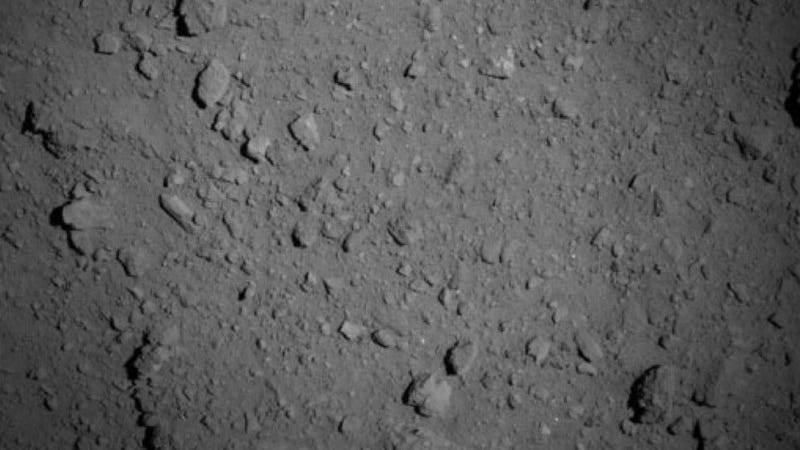 Ryugu’s surface as seen from a distance of about 0.6 miles (1 km)Image: JAXA, Tokyo University, Kochi University, Rikkyo University, Nagoya University, Chiba Institute of Technology, Meiji Univ., Aizu Univ., AIST
Ryugu’s surface as seen from a distance of about 0.6 miles (1 km)Image: JAXA, Tokyo University, Kochi University, Rikkyo University, Nagoya University, Chiba Institute of Technology, Meiji Univ., Aizu Univ., AIST
Earlier today, Japan’s Hayabusa2 spacecraft came tantalizingly close to Ryugu, offering an unprecedented view of the asteroid’s boulder-strewn surface.
Two weeks ago, Hayabusa2 came to within six kilometers (3.7 miles) of Ryugu, but today’s descent, the third of the mission, saw Hayabusa2 come to within 851 meters (2,800 feet) of the asteroid, making it the closest encounter to date. Mission planners are preparing for a procedure that will see Hayabusa2 collect samples of rock and dust from Ryugu’s surface. Today’s descent was done to measure the weak gravitational pull exerted by the kilometer-wide asteroid.
Ryugu’s surface from an altitude of about 1,250 meters (4,100 feet)Image: JAXA, Tokyo University, Kochi University, Rikkyo University, Nagoya University, Chiba Institute of Technology, Meiji Univ., Aizu Univ., AIST
The latest descent began yesterday (August 6) around 11:00 a.m. Japan time, when Hayabusa2 was about 20 km (12.4 miles) away from Ryugu. At around 8:30 p.m. the same day, the probe began to free fall towards the asteroid upon reaching an altitude of six kilometers (3.7 miles). Hayabusa2 got to within 851 meters of the asteroid around 8:10 a.m. today, at which point it engaged its thrusters to move away from the rock again.
During the descent, Hayabusa2 snapped photos with its telephoto optical navigation camera (ONC-T) and its wide-angle optical navigation camera (ONC-W). The 10-meter (32.8 feet) scale bar at the bottom of the photos provide the needed perspective. What looks like a few rocks strewn across the surface are actually large boulders.
During the gravity measurement operation, JAXA scientists carefully monitored the movement of the spacecraft as it made its free fall and rise, observing the strength of the asteroid’s gravity on the probe. JAXA still has to decide where it wants the probe to extract its surface samples, and where to deploy the additional tiny surface probes. This should happen in a couple of months, with the probe hopefully returning to Earth with its samples in late 2020. But as these new photos show, Ryugu’s surface is complex and treacherous. Choosing an ideal landing site won’t be easy.
[JAXA Hayabusa 2 Project]